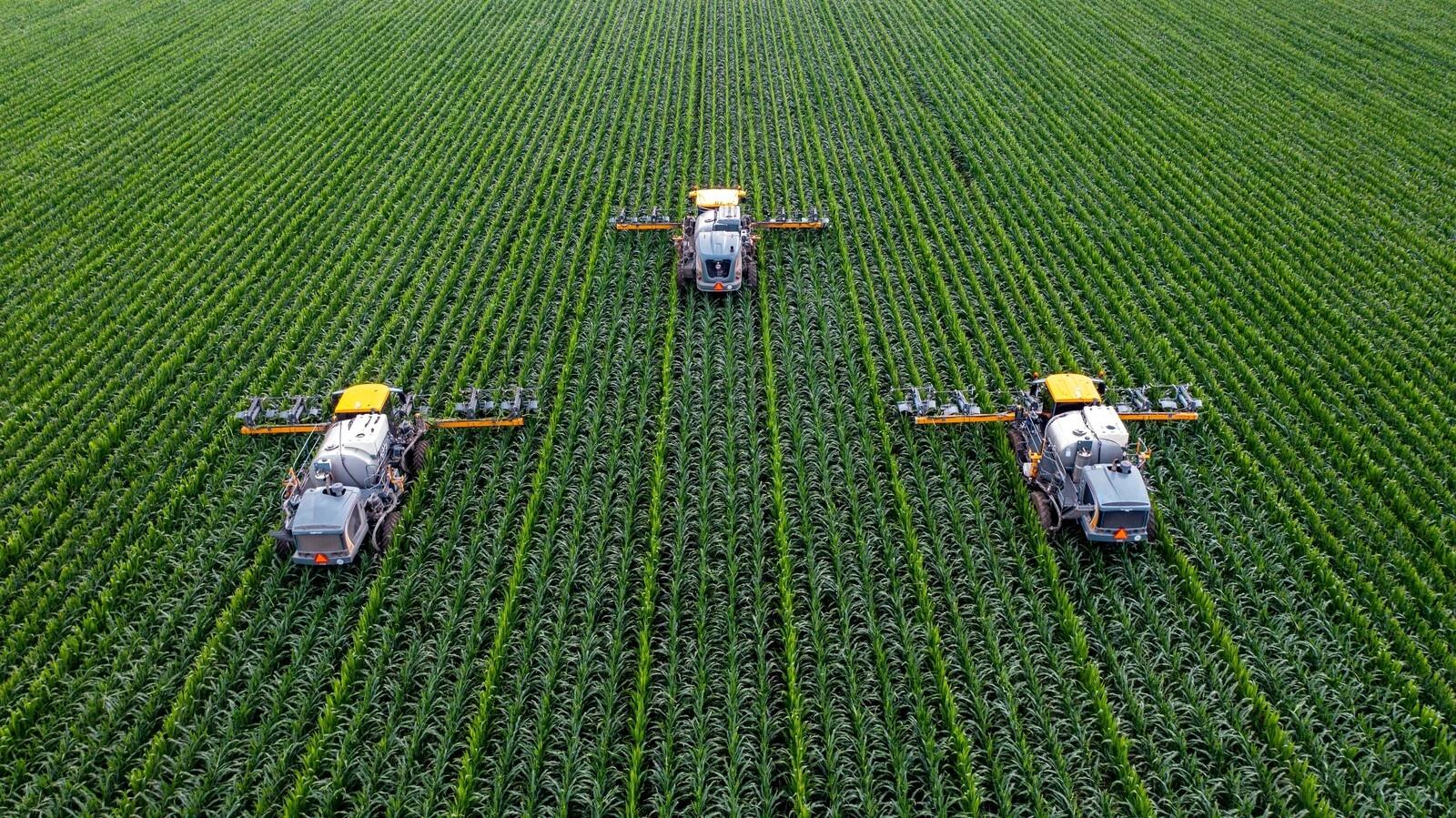We need to move towards sustainable agriculture practices.
- The entire food ecosystem needs to provide sustainable, nutritious food for a growing population.
- Technology, finance and public-private partnerships can support the adoption of sustainable farming.
- We asked three farming leaders what’s needed to unlock resilience across food systems.
We have a leadership imperative and a responsibility to build resilient and equitable food systems that can nutritiously feed the growing population within planetary boundaries. Farmers as stewards of our food systems are leading this shift towards producing food that is more sustainable, nutritious, and accessible, leaving no one behind. The entire food ecosystem needs to work together to secure these transitions. This means fit-for-purpose innovation, coordinated capital and incentives, agile and multisectoral partnerships which together create solutions that are co-designed for practical at scale adoption by the whole value-chain.
A new report by the 100 Million Farmers initiative, Breakthrough Models for Financing a Sustainable Transition, outlines how to support and work alongside farmers, with a specific focus on speeding up the adoption of regenerative agriculture pathways. The model suggests de-risking transitions by aggregating capital from public and private sources to overcome initial financing costs, thus contributing to the key question of how we unlock resilience across the complexities of the food systems.
We asked three farming leaders to share their thoughts on their greatest worries and most hopeful solutions.
Top challenges for sustainable agriculture?
Megan Miller, Agronomy Manager, Illinois Soybean Association (ISA), USA
The lack of alignment along the agricultural value chain creates marked challenges for farmers in the transition to conservation agriculture, which often results in reduced/changed inputs, complicating production and profitability. Further, each stakeholder in the value chain places a different value on sustainably produced grain. Being in the middle of the value chain, farmers are squeezed by the demands before (land and input costs) and after (grain pricing and practice requirements), while still maintaining their profitability and ability to farm. Rising labour costs and shrinking rural populations also hamper the introduction to new farming methods while maintaining scale of operation.
Betty Chinyamunyamu, Deputy Chief Executive Officer, The National Smallholder Farmers’ Association of Malawi (NASFAM), Malawi
Farmers, including smallholders in Malawi, like farmers across African countries, see transitioning to sustainable agriculture as an immediate necessity. The risk of not transitioning is loss of livelihood in an economy that does not offer many alternative sources.
However, extension training is limited, coupled with lack of access and awareness of appropriate technologies and innovations. Further, these innovations are expensive, leading to low adoption. This is more evident for female farmers whose access is significantly lower. In addition, smallholder farmers are risk-averse, affecting willingness to adopt new practices.
In Malawi, where the farmers depend on one growing season through rainfed production, with limited access to crop and weather risk insurance, the hesitancy to change farming practices is due to fear of loss of crop, high costs and no hope of recovering through winter/irrigation farming.
Arnold Puech D’Alissac, President, World Farmers Organisation (WFO)
The top challenge for the farmers engaged in the transition is the need to maintain socioeconomic profitability while producing sufficient food, fibre and energy. This requires the adoption of practices that embed investments in knowledge, technology and production models.
According to the WFO Global Producers Consultation report Climate-Smart Agriculture from the AgMission™ initiative, the lack of efficient multistakeholder approaches is one of the biggest barriers to the adoption and retention of climate-smart agriculture practices. This is reflected in the limited access to financial resources and technological innovation where farmers are facing the impacts of climate change and taking responsibility for the transition. There is a need to: enhance farmers’ capacity to access funds for investments at the farm gate; and establish financial mechanisms tailored to the farming cycle structures and income models.
A truly just transition must: enhance farmers’ ability to face the threats of climate change; facilitate the intergenerational transition and/or create attractiveness in farming for young generations; ensure a fair income; and preserve the community’s well-being while sustainably feeding a growing global population.
What partnerships and investments might mitigate transition risks?
Megan Miller, Agronomy Manager, Illinois Soybean Association (ISA), USA
Currently, disparate incentive programmes exist across the value chain, from input companies, elevators to consumer goods and the benefits of conservation agriculture do not reach the farmers. Enrolling in a programme managed by one player in the value chain often excludes the farmer from enrolling in another. Programmes aligning the entire value chain through science-based standards and definitions for conservation outcomes, as well as lowering burden and securing data sharing would help mitigate transition risks for farmers.
Research that maps ecosystem services and the measurement, monitoring, reporting, and verification (MMRV) methods is needed. Many groups are working to monetize ecosystem services such as carbon sequestration, water quality, or biodiversity. While carbon credit markets have the most technical infrastructure for quantification and monetization, continued research funding is needed to quantify and understand these benefits on a global scale.
Funding for the development of third-party, in-field technical assistance is also needed. Programmes that allow for the trial of new practices with the aid of local experts will lead to a community that values food security and environmental outcomes.
Betty Chinyamunyamu, Deputy Chief Executive Officer, The National Smallholder Farmers’ Association of Malawi (NASFAM), Malawi
Farmers need partnerships with research institutions, development agencies, NGOs and innovation hubs to deploy appropriate technologies and understand benefits, making adoption easier. Technologies are often inaccessible due to cost or expertise. Partnerships must be allowed adequate time to bear results as farmers normally adopt a “wait and see” attitude.
These partnerships must fully engage farmers throughout the process of developing sustainable technologies, implementing, and monitoring impacts. Adoption of practices is easier with an involvement during design and not just implementation.
It is important to acknowledge the role that farmer organizations play in bridging gaps between the farmers and stakeholders. These organizations offer the best opportunity of engaging with a more empowered, informed and objective group of farmers.
Arnold Puech D’Alissac, President, World Farmers Organisation (WFO)
Farmers alone cannot bear the cost of a societal change on imagining the future food systems. As stated in the Food Producers’ Declaration for the United Nations 2021 Food Systems Summit, “We are in this together, and only together we will succeed.”, Farmers are keen to engage with other actors to ensure policies tailored to their needs. Their involvement in decision-making processes, research and innovation design is a pre-requisite to achieve these ambitious goals, along with the investment in the identification and scale-up of effective climate solutions. This approach goes hand in hand with a decentralization of power in the food value chain where farmers should be treated as equal partners in contract farming.
Agriculture is a sector that simultaneously can adapt to and mitigate climate change while also providing carbon sequestration services. This role belongs to the farmers and must be recognized by the other actors of the value chain, policy-makers and society.
All this is possible through the reinforcement of farmers’ organizations and cooperatives that can partner with the other actors in food systems to facilitate and accompany the full commitment of farmers to the transition.
What are you most hopeful for in the future?
Megan Miller, Agronomy Manager, Illinois Soybean Association (ISA), USA
The increased acknowledgement that we can work with farmers to address climate change while still working to ensure food security for the world’s population is leading to opportunities for alignment along the supply chain. I’m thankful to work for the board at the Illinois Soybean Association (ISA). We work with research partners such as the University of Illinois to understand and quantify the benefits and trade-offs of conservation practices on water quality and carbon sequestration by combining remotely sensed data with science.
Helping to scale conservation finance programmes by partnering with Illinois Corn on the Precision Conservation Management Program and the Iowa Soybean Association on the Soil and Water Outcomes Fund is allowing our farmers to understand how they can work as leaders in aligning the value chain. These efforts are now expanded to a state-level cover crop adoption, incentives, and training opportunities for technical assistance providers. There is also an opportunity to partner with other stakeholders to provide online and in-field technical assistance aimed at helping farmers overcome barriers to adoption.
Betty Chinyamunyamu, Deputy Chief Executive Officer, The National Smallholder Farmers’ Association of Malawi (NASFAM), Malawi
Smallholder farmers in Malawi are resilient and keen on the transition. I am hopeful that stakeholders will put smallholder farmers at the heart of sustainable agriculture and in developing solutions. I am hopeful for greater coordination and collaboration so that contradictions in approaches are minimized.
I am hopeful that smallholder farmers will be properly and adequately supported so that they are able to produce the quantity and quality of food that the world requires. I am hopeful that all farmers (from large to small) will be able to produce more, with less; be more resilient and manage a transition to sustainable farming.
Food is at the centre of all livelihoods. The responsibilities of having food and nutrition security are on all of us. We cannot allow farming to collapse into a global crisis and the need for transition is now. I am hopeful that the plight of farmers in a challenging climatic environment will become clear to all actors and push them to the right actions to support all farmers.
Arnold Puech D’Alissac, President, World Farmers Organisation (WFO)
We are hopeful that the international community will understand the urgency to act and the need for a shift of paradigm from having farmers at the receiving end of decisions to putting us at the front and centre of the transition.
The geopolitical situation and global economy are among the main variables of a stable business environment for farmers. We all remember the high fluctuation of prices of agriculture inputs and products in recent years, either due to political instability or speculation. Farmers, especially family farmers, are already facing the challenges linked with the impacts of climate change and increased natural disasters, compounded by a fragmented sector and geopolitical turmoil. Hence, we are hopeful for political stability and market predictability, that can only have a positive effect on the farmer resilience.
Farmers are ready to sit with other actors to address the decisions needed to make the transition. Our main hope is that the others; governments, the private sector, NGOs and civil society, multilateral organizations, and the research institutions are ready too to sit with the farmers and consider us as strategic allies to enable the transition.
Only accepting this shift in paradigm can lead to a more fair and transparent distribution of power, responsibilities, and new business opportunities.
By: Tania Strauss (Head, Food and Water, World Economic Forum)
Originally published at: World Economic Forum









